Uber founder Travis Kalanik - "a rebel in the elite of Silicon Valley"
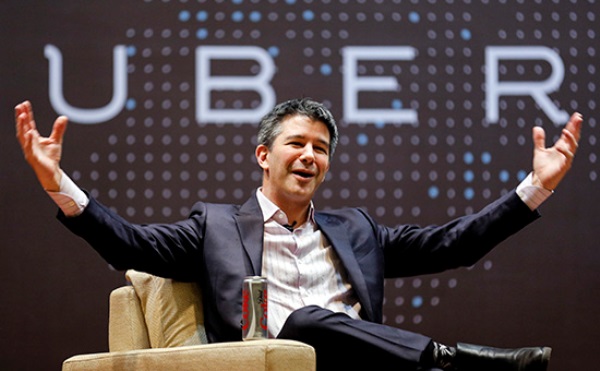
Founder and CEO of Uber Taxi Service, Travis Kalanik, will visit Russia for the first time .
Kalanik will arrive in Moscow on Sunday, June 5, and in the evening of the same day will give a lecture on the development of transport in the 21st century at the Strelka Institute of Media and Design. Kalanik will tell the audience “whether carsharing and improved public transport will drive out private cars and whether hybrid and electric cars will replace conventional gasoline and diesel vehicles,” a statement on the Strelka website said.
')
Service to call private drivers Uber - the fastest growing company in history. Uber raised from the state fund of Saudi Arabia $ 3.5 billion. According to estimates of The Wall Street Journal, the estimate of the most expensive startup in the world came close to $ 68 billion.
By his 39 years, Kalanik had become one of the richest entrepreneurs with a fortune of $ 6.2 billion. The identity of the founder of Uber is a controversial reaction from both the public and people familiar with him personally: some hate him, and some admire him.
Happy business childhood
Travis Kalanic grew up in the Northridge area on the outskirts of Los Angeles. He has a brother, who became a fireman, and two stepsisters. My father worked as an engineer, my mother sold ads in the Los Angeles Daily News. As a child, Kalanik dreamed of becoming a spy. What would be his way in this field is unknown. But no one would argue that Travis from childhood had the makings of a seller. In his school years, he already walked around the porches and sold Cutco brand knives.
“I had a feeling that he was constantly trying to sell something to me,” recalls Kalanik’s classmate. Another classmate remembers him as a great storyteller, energetic and looking for benefits at all costs.
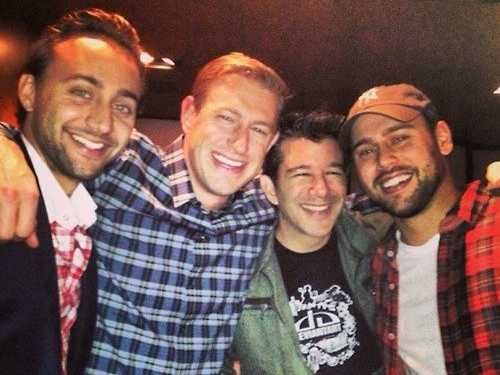
First business
At the age of 18, Kalanik launched the first business course in preparation for the SAT test “Academy of New Thinking”. SAT consists of three parts - mathematics, text analysis and grammar. For each given a maximum of 800 points, a total of 2,400 for three.
Kalanik claimed that the first student who completed his course “1500 and more” improved the result by 400 points. Kalanik himself scored 1580 in the first two parts. He was summed up by two questions on linguistics, writes Business Insider. In numbers, as Kalanik likes to boast, he understands much better than words, and can solve the mathematical part of the SAT in eight minutes.
After high school, Kalanik entered programming at the University of California at Los Angeles, receiving almost maximum points on the SAT.
First failure
At university, he met his first partners, Michael Todd and Vince Busam, with whom he began work on Scour, a file-sharing service. Sean Fanning, one of the first users of Scour, launched a similar startup in 18 months - Napster . Kalanik more than others engaged in marketing and advertising. To promote the product Scour Exchange (SX), he even hung bottles of lubricant on the door handles of rooms in the dormitory, sticking stickers on them with the Scour logo and the phrase “Do not open, SX works”.
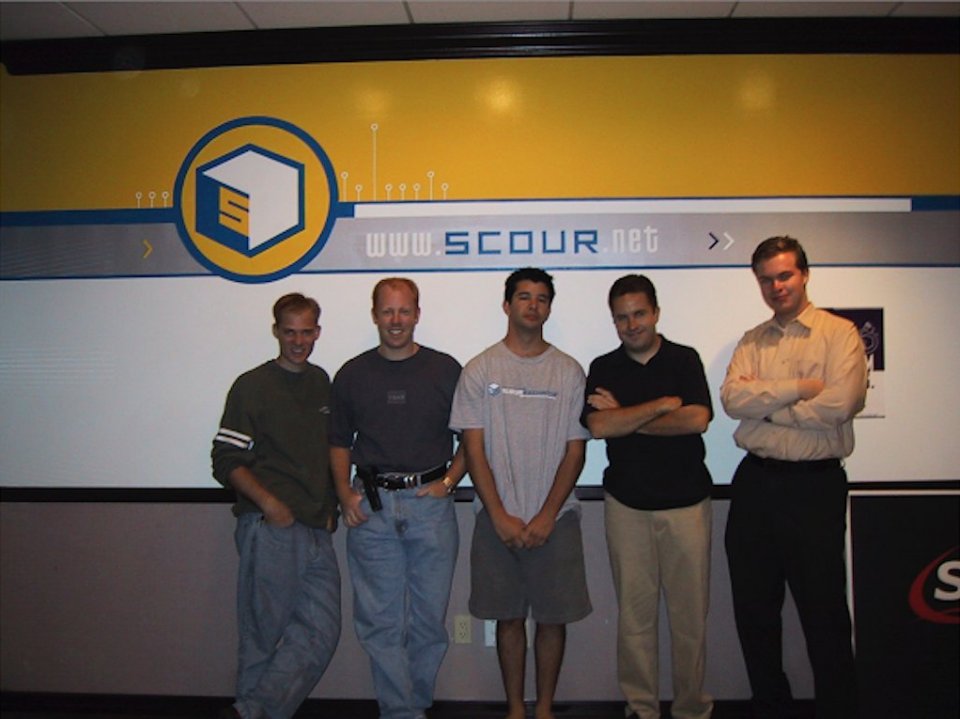
“Kalanick negotiated in such a way that everyone around him forgot that he was only 20 years old,” says former Disney CEO Michael Hovitz, who bought 51 percent of Scour with the billionaire Ron Berkl. Later, watching how Kalanik communicates with the authorities, Hovitz will say that the head of Uber is the person who “you send to the ring, and he always wins.”
Scour existed for three years until it received a lawsuit from 30 major media companies that accused the service of copyright infringement in the amount of $ 250 billion. The company had to declare bankruptcy. Kalanik took it as a personal defeat and did not go to the cinema for a long time, so as not to see on the screen the logo of Universal Pictures and other corporations that killed his brainchild.
RedSwoosh and Jam Pad
Speaking at the conference FailCon, where entrepreneurs talk about their failures, Kalanik reported on a new project. He was associated with a cunning plan for revenge against the “murderers” of his past project. The idea was to get 30 companies suing Scour to pay him. He hoped to distribute free or licensed content and receive money from each company that filed a lawsuit against Scour. This is how the RedSwoosh file hosting service appeared - a service that allows you to cheaply transfer large files like high-quality photos and videos.
According to The Fortune, in the end, 23 of the 29 companies that sued Scour either became RedSwoosh clients or periodically distributed their content with it. But soon Kalanik’s money ran out: he had nothing to even pay a salary to seven employees.
In 2007, Akamai paid $ 23 million for RedSwoosh . With the money raised, Kalanic bought a large house in San Francisco with a tennis court and a good view, called it Jam Pad and began to hold so-called jam sessions there, during which businessmen discussed their ideas. Kalanik often hosted startups.
Offering his accommodation to the participants of an IT conference, he described it as “a place where entrepreneurs regularly hang out, give ideas and eat fantastic dishes cooked by the Jam Pad chef”. He invested a lot. “If Travis liked you, he invested in your company and helped for free,” recalls Greg Krechmar: when he was looking for money for a Livefyre startup, Kalanik introduced him to 45 investors in less than a week and invested himself.
Uber
In 2008, Kalanik met at one of the conferences with StumbleUpon founder Garrett Camp. He told how in the New Year he hired a limousine with a driver for $ 800 with friends. Camp price seemed predatory. He came up with the idea to develop an application that will allow sharing the car with other applicants from Silicon Valley.
In 2009, they, together with Kalanik, created Ubercab, a mobile application that allowed calling a personal driver with one click. Then the service was used by friends in San Francisco, very few people took it seriously. When Kamp asked Kalanik if he would do it all the time, he replied in the negative: it was risky to completely devote yourself to such an adventure.
A year ago, the founder Travis Kalanik was accused of stealing ideas and technologies. Allegedly, Kevin Halpern from California created a prototype of a service for ordering a taxi through a mobile application many years ago. The entrepreneur claimed damages amounting to one billion dollars.Ubercab argued a lot about the future. Some said that the service should be focused on the luxury segment, adding the functions of ordering helicopters and airplanes. Others suggested making Ubercab massive, allowing to drive expensive black cars cheaper than the market as a whole. So did Kalanik. He reasoned: “The more people want to use it, the more drivers will be ready to provide such services. The competition will increase, the cost will decrease, and the time of the car delivery will decrease. "
Halpern claimed that he developed his prototype back in 2002, at his company, Celluride Wireless. They met with Kalanik in 2006. Then Halpern and showed him his achievements. Kalanik allegedly used them to create his own project. Noteworthy is the mention of their re-meeting in 2008. It was then that he revealed to Kalanik the details of the project. A year later, the Uber service was launched. Representatives of the company are convinced that the claims are unfounded.
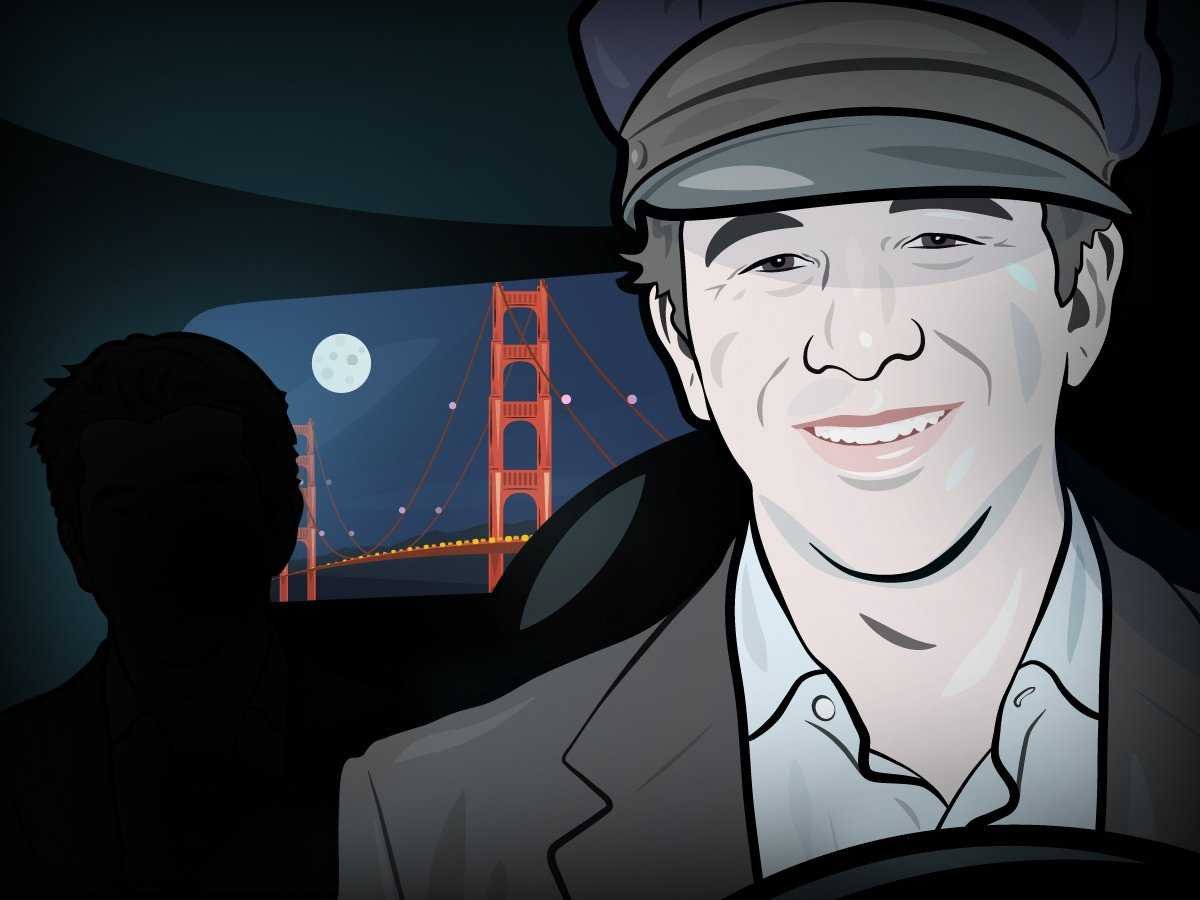
Travis Kalanick's parents were the first passengers of Uber, launched in Los Angeles.In October 2011, Kalanik attracted the attention of leading venture capital investors to the project, including Netscape co-founder Mark Andriessen, who joined the board of directors of the service. Shervin Pishevar of Menlo Ventures bought the stake and invested $ 20 million. The service invested Jeff Bezos, head of Amazon. Uber began to use the Hollywood stars with whom Kalanik was familiar: Ashton Kutcher, Jay Z, Edward Norton and others.
Thanks to this, Uber became famous. In five years, the company received $ 8.21 billion from leading venture capital funds, hired 3,000 employees and opened offices in dozens of countries. Kalanik succeeded in what Facebook and Google did not succeed in - entering the Chinese market and winning an audience, despite the resistance of local players.
It's not easy to get to Uber, but even harder to leave
Currently, Uber has about 6,700 employees, and the number of those who left in recent years is minimal by the standards of a major startup. The reason is simple - Uber has complicated the exit process for employees by issuing options for potentially large amounts.
For example, if issuing a 0.5% stake as a bonus at the start and subsequent investments in the region of $ 11 million, as well as an estimated value of $ 60 million as of 2011, this block of shares would be worth $ 300 thousand. With a capitalization increase of up to $ 60 billion, such a block of shares would rise in price to $ 299.7 million. But when leaving Uber, the employee must pay a tax of $ 119.8 million within 90 days. Moreover, the obligation to pay tax comes into force immediately after leaving Uber.
For its part, Uber imposes restrictions on the sale of stakes in the third market, prohibiting the transfer of their shares to venture funds or to private investors.
Earlier, Kalanik himself sold part of his shares to Uber. One of the journalists asked the entrepreneur if he was considering selling the entire company. However, the CEO of Uber said that the sale of part of the shares was planned as part of a startup development strategy.
“What kind of reaction do you expect if you ask a happy married man, who will be his next wife?”, The company’s founder asked a counter question. “I had wives,” he continued with a smile. “But now I’m focused on only one (Uber), ” Kalanik said .
“Over the past 1.5 years we have attracted more than $ 10 billion, so we have money. Our partners attract billions of dollars and go into debt. However, our task is to be disciplined in setting up a business, ”he added.
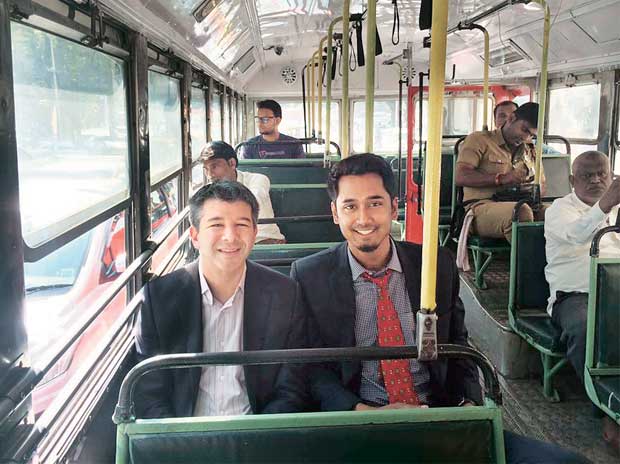
Leadership style
“I like to think of myself as Wolfe from Pulp Fiction,” Kalanick once told a group of Chicago entrepreneurs. He considers himself a cold and rational person who never stops.
Kalanik loves to argue. When CTO Uber Tuan Fam joined the company in 2012, Kalanik called him every day for two weeks in a row asking how best to communicate with the engineers. They discussed a lot. As a result, Fam realized that Kalanik wanted the employees to disagree with his every word, but expressed their proposals. In the end, the best ideas win.
Kalanik claims to manage a rapidly growing company through two lists. In one - the problems that need to be addressed every day, in the other - the ideas that need to be implemented. Kalanik keeps track of all the details, but at the same time gives more freedom to managers. Every Monday he holds a meeting with employees and talks about the immediate goals.
Personal life
Since 2015, Travis has been meeting with violinist and columnist for Huffington Post, Gabi Holzwart.
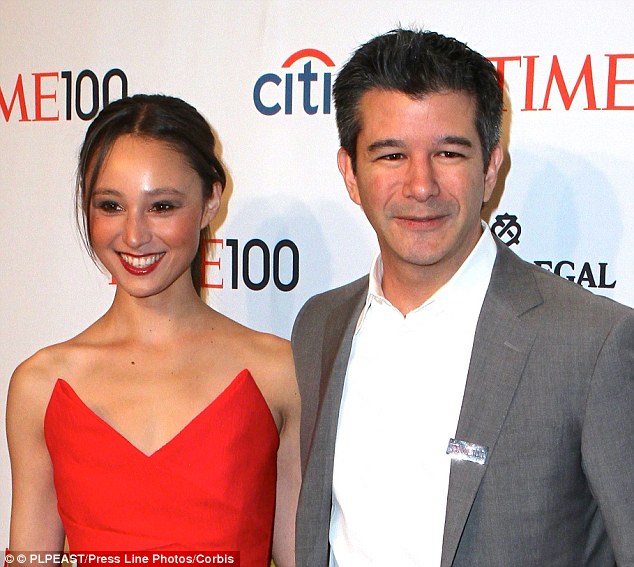
Personal qualities
"He is not sleeping. He does not lose focus. He sometimes even forgets that he is hungry. He tries again and again, inspiring others with his passion until the very end of the game. So, if Travis decided that he wanted to make a cleaner, safer and simpler taxi service than he currently has, he would do the job. If he set his sights on reforming the corrupt, penetrating everywhere and against the consumers of the regulatory system, you will see that it will soon collapse, dragging along those who have brought it to life with their dishonest bargains. If he wants to kill the racism that keeps people of different skin colors from getting access to a taxi, he will achieve what he wants, ”his acquaintance Chris Sakka writes about Kalanika.
He stubbornness knows no bounds. One day, he spent nine hours in a row at Google’s office, persuading one of the employees to go to him.
Kalanik has always been ambitious. This helped him to 37 to take the 13th place in the list of Fortune entrepreneurs "40 to 40" : the publication called him "a rebel in the elite of Silicon Valley."
“People ask me: things are going so well, do you feel great too? But my approach to life is such that I always feel some discomfort, ”admitted Kalanik,“ I always feel the same as 15 years ago. ”
Familiar Kalanik say that duality is part of his character, and perhaps one of the reasons for success. Ideology - inconsistency.
One night, he waited at the club for his friend Sean and quarreled with the guard. He asked him to leave. “I am not breaking the law,” Kalanik repeated, not moving from his seat. The guards called the police, Parker had to pay $ 2,000 to save a friend. In another Kalanik with RedSwoosh employees flew to Mexico. He got into a taxi, but decided that they want to cheat him, and refused to pay. The driver blocked the door, the entrepreneur had to jump out of the car on the go.
Founder's advice from Travis Kalanic
In January, the publication The Secret of the Firm published fragments of a lecture by Kalanik at the Indian Institute of Technology in Mumbai:
The essence of a startup in the constant problem solving. That is why I love engineers so much - no one knows how to overcome difficulties better than them. That is what they do every day: they turn broken things into working ones.
Entrepreneurs should be like mathematicians who adore difficult tasks. A passion for finding problems and solving them will turn you into a good entrepreneur.
Smart startups know that even if their idea doesn’t work, there are a thousand companies that will hire them, but they will still be better and smarter because they tried to do something that no one tried.
You should not be a winner, but a champion. If you fall, rise again and again until you succeed. Failure is a state of mind. There was a period in my life when I had failed six years in a row, but each time I started all over again.
On the other hand, you need to be able to switch in time. If you spend all your strength on making the idea work, and in return receive only physical or emotional suffering and are not moving forward at all, it is better to switch to something else.
Most people have good ideas, but they rarely implement them. Uber is a good idea. I do not know if we were the first to invent it, but we were definitely the first to do it.
Do not wait for the investor to speak first. This is the worst possible alignment. Think of your business as a chess game. You play chess for 80 hours a week, so you constantly need to monitor the position of the pieces on the board and always be ahead of your opponent by five to six moves.
The main task of an entrepreneur is to become an expert on chess and predict the opponent's moves. In this case, when the investor offers you something, you will say: “This is interesting, but I can name 1800 reasons why it does not work. Here are 3,650 reasons for making the right move. ”
If you do not know how to find a common language with people, you need to find a co-founder who can do it. If you are an introvert and cannot promote a project, find someone who can. If you are not energetic enough even to find an energetic person, it will be difficult for you.
The path of the entrepreneur is often associated with loneliness. Having a partner is very useful, especially in difficult times (which at first occur too often). The fun begins only after five years of hard work.
Source: https://habr.com/ru/post/302554/
All Articles